

The unbelievably photogenic St Monan's Harbour and surrounding coastal area, including Elie Bay (Part 1 of 2) |
Foreword: This is going to be quite a long two part chapter, due simply to the vast amount of photo opportunities that can be found, in these tiny but very picturesque locations, on the East coast of Scotland. Which after reading the text below and looking at the accompanying pictures, if you decide that you too would also like to come here and have a go at photographing these amazing locations for yourself. Then I am advising, that you should bring along a variety of lenses with you. From 16mm wide, through to a 400mm zoom, or even a 500mm super telephoto lens if you have one and with everything else in between. I would also suggest, that you bring along lots of your filters with you, such as a circular polariser, grads and your 3 and 10 stop ND's. You will also be mainly shooting from a tripod and using a remote release (or your in-camera timer). That is if you want to recreate, some of the many shots I am about to show you, throughout this two part chapter. Although I suppose you could get away with going hand-held if you really must. But which I do believe, may severely limit what is available to you if you do. Oh and don't worry too much, about having to lug all that heavy kit around with you, for each shot that you take and giving yourself backache. As you will be mainly working from the side of your vehicle, or at least close enough to it, to allow you nip back and swap out a lens or two, or throw on an extra filter etc., if required. So let's get to it... |
|
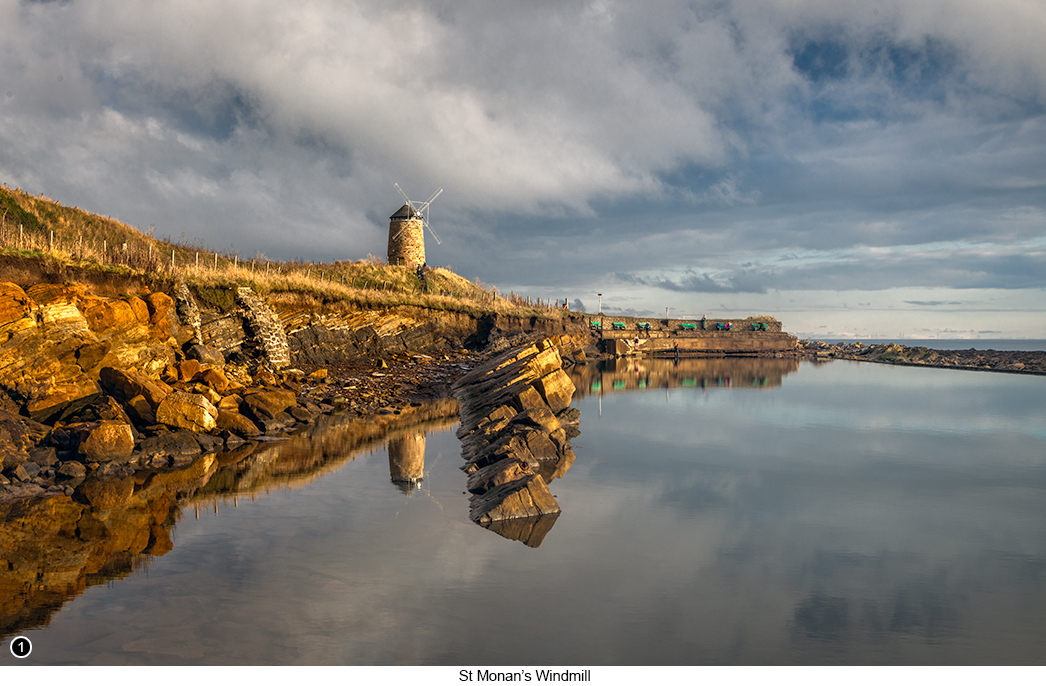 |
|
Setting the scene: The St Monan's harbour and bay area, for all it's obvious prettiness and photogenicness (is that even a word?), that you will find here today, is only due the ingenuity of man and both the men and women who once lived and toiled here, as they slowly transformed and reshaped this part of the coastal landscape, over many generations. Because what you are seeing all around you, as you wander around this tiny bay area with your camera, is the result of what would now be classed as 'heavy industry' and the very beginnings of the industrial revolution. But that predates the true industrial revolution, by many, many decades. So if you had been unfortunate enough to arrive here in the mid 1700's, you would have been greeted by the large puthering clouds of thick black smoke, emanating from the 24/7 burning of locally mined coal and the acrid stench rising up from the long line of salt making 'Pan Houses', as they constantly worked to crystallise, as much salt as they could out from the sea. Under a toxic atmosphere that was so bad, it would instantly turn your eyes red and begin to stream with tears, as you also started to cough and gasp for clean air. You see back when this area was in its full industrial money making heyday, there weren't such things as fridges or freezers etc. Nor were there chemicals preservatives available, that could be added to food to extend its shelf-life. So the only thing that could be done to preserve food and keep it edible for more than a day or two, was to salt it and preserve it and this is where a large proportion of the salt, for the entire UK food supply came from. |
|
To read the text in the graphic below, click anywhere on it, to load a larger sized version into a new window |
|
These are just a few of the information boards, you will find dotted all around the St Monan's area. |
|
How to get there: Heading North from Edinburgh and then crossing over the very impressive Queensferry Bridge, continue driving North along the M90 for around 20 miles, until you see a motorway sign coming up on your left, signposted for the A92 route to Glenrothes and take this exit, Street View - Map View. Then continue driving on the A92 for 7 more miles, until you reach a road traffic island and where you will then turn right, along the A921 to Kirkaldy and the Fife Coastal Tourist route, Street View, Map View. Then at the next road traffic island, turn left on Randolph Road heading towards the A915 and St Andrews, Street View, Map View. So carry on driving further up the A915 for several more miles, until you reach the village of Upper Largo and a 'T' junction and turn left (East), heading towards the village of Elie and the A917, Street View, Map View. Now continue on for another 8 miles, heading North East along the A917, until you finally reach the turn off, for the tiny seaside bay of St Monan's on your right, Street View, Map View. |
|
|
All the streets from this point, that run through the tiny seaside village of St Monan's, become very, very narrow indeed. So even though we are still allowed to drive along them without restriction, you must bear in mind, that these roads were originally created, for use by hand carts and horse drawn carriages. But are still none-the-less, just about wide enough to squeeze a modern sized family car through, if you take care. So be prepared to take your time driving in this area, as well as being prepared to negotiate your modern sized vehicle, through several tight width, dog legged bends. Alternatively, if you are filled with dread at the thought, of trying to drive your shiny new 'Urban Tank', through such narrow road width conditions, then you could always park in the upper part of the village, near to the shops on the left and then walk the few yards down into the village itself. So continuing down to the St Monan's village car park, as you now follow the road into St Monan's, from the right hand turn off the A917 and all the way down to the harbour area. You will then arrive at a 'T', junction, with the harbour wall arcing around to your right in front of you. Turn left along Mid Shore Road, as you now head for the St Monan's Windmill parking area, Street View, Map View. Then drive on a few hundred yards further along the Mid Shore Road, with the harbour still to your right, until you arrive at an open junction, where the road now seems to split into three. So take the middle Mid Shore Road option and where Mid Shore road then becomes Forth Street, Street View, Map View. |
|
You will then begin to drive up a slight incline along Forth Street, until you see an even smaller road to your right called Rose Street, Street View, Map View. So take this right hand turn along Rose Street (very narrow) and drive all the way to the end. When you have driven down Rose Street, all the way until you reach the end of it a couple of hundred yards further on. You will then see the official car parking area on your right. So park your vehicle here wherever you can, Street View, Map View. You should now be able to see the St Monan's Windmill and its foreground tidal pool, just a few hundred yards further up the coast to your left and is where you are now going to walk to, for the view of the windmill, as shown SHOT 1 above. So jump out of your vehicle and head off up the path towards the windmill, with the rugged rocky coast now on your right. Then as you get near to the windmill, you will see over a wire fence to your right, where there are a set of old stone steps, leading down to the front edge of the pool. There is actually an entrance point to these steps, but for whatever reason, the council has deemed them to be too dangerous or something, so has blocked them off with a fence. But it is only a relatively low fence, that is very easy to step over - cue the Judas Priest's track, Breaking the law, breaking the law..etc. I suggest you use your wide angle zoom for SHOT 1, as shown above. Because to get all of the reflective tidal pool and the foreground rocks fully into the shot, as well as allowing you to place the windmill, on a nicely balanced compositional point within the upper left(ish) third of the image, means you are going to be shooting wide. |
|
So once you have made your way over the fence (Breaking the law, breaking the law..etc), if you now walk down the half a dozen steps to the bottom, you will find there is a flat concrete platform, that sits right on the edge of the tidal pool and which is in just the right place and of just the the right size, to allow you to comfortably set up your tripod, for the view shown in SHOT 1 at the top of this chapter. Now when you are here, you will see there is also a small flagpole to the immediate left of the windmill, but that stands far enough apart from the windmill at this viewpoint, to allow you to easily clone it out later if you wish and as I have done here. Although I did originally leave the flagpole in the shot, as it is a relatively small thing and didn't really affect the composition negatively. But then later on, when I was looking again at this image on screen and because the flagpole was white and reflecting the light so brightly, I found it kept drawing my eye towards it, rather the the main subject of the windmill to its right. So I removed it with the clone tool (and don't forget to do its reflection at the same time). But of course you may wish to keep it in your shot, because as I say, it didn't really harm the composition, other than it being so bright and attracting to the eye. |
|
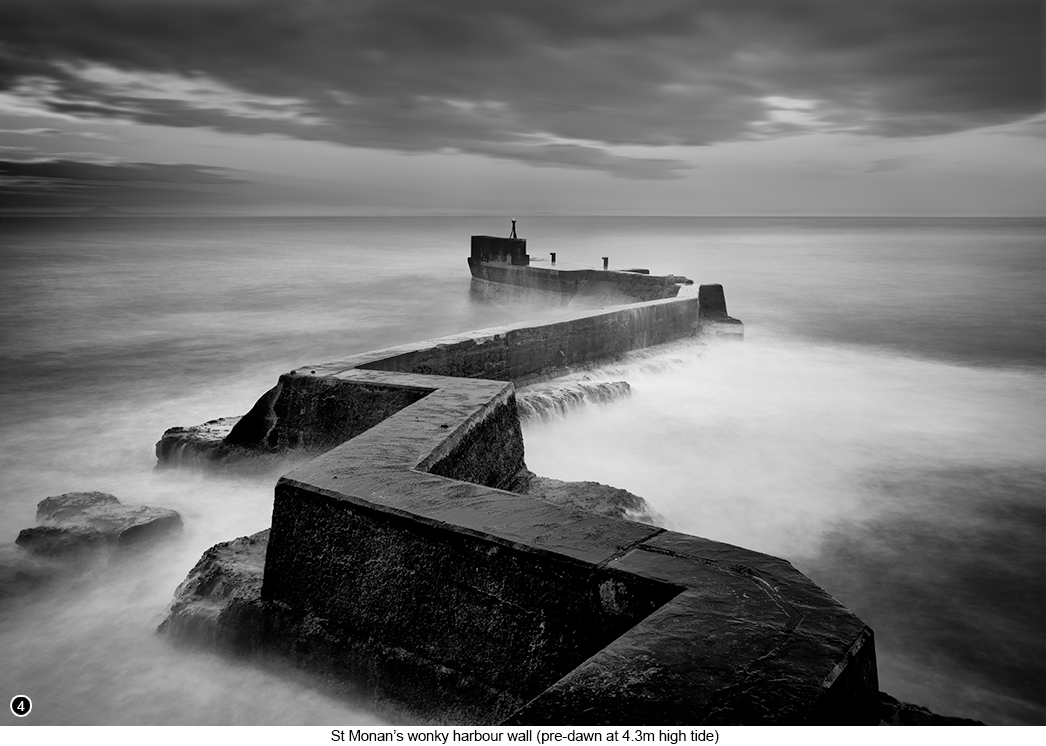 |
|
So having now taken your shots of the windmill, as shown in SHOT 1 above and the large reflective pool in front of it. If you now walk back to your vehicle and then keep on going past the car park and all the way onto the other end of Rose Street. You will see the tiny harbour of St Monan's open up in front of you and the modern harbour wall that arcs around from your left to your right. However you will not be able to see the "wonky" part of the much older harbour wall at this point. So keep walking down the left side of the harbour, passing a modern block shaped looking seafood restaurant on your left and continue on, until you arrive at an old vertical iron ladder, that you can now climb to the top of the newer harbour wall, for the view of the older, wonky part of harbour wall. Then once on top of the harbour wall, set up your tripod just to the right of the handrail (so you have something to hang onto if it is windy, or if you have a fear of heights), which will then allow you to take your shots of the older, wonky part of the harbour wall, as shown in SHOTS 2, 3 and 4 above. Please Note: in images 2, 3 and 4 shown above, when I refer to the depth of the high tide in the title, I do not mean this was the highest point of the tide when I was there, but only my guess at how far the tide had risen, at the moment I took the shot. So when is the best time of year to be here, to get anything like the shots shown immediately above? Well for me and after visiting this location several times, I knew I had to be here in winter, when the arc of the rising and setting sun, would be low enough to throw some colour into the scene at both ends of the day. I also knew I would like it to be a high tide, so I could capture the waves crashing over the top of the wall, as it often seems to do here, whenever the highest part of tide is forecast to be over 4m. Do I need to tell you to be careful up on this harbour wall and to not do anything daft, or to take any silly chances? I mean I will if you want me to.. OK I will, so here goes... If you do choose to be here at high tide and if the sea is in a particularly angry mood, then the waves will not only be crashing spectacularly, over the wonky part of the older harbour wall in front of you, but they will also come crashing up to and then over the part of the wall, where are now standing. So it really should not need to be said, that if the conditions are too stormy (and therefore dangerous) when you are here, then you need to make yourself err on the side of caution, admit defeat and come back for another go at this location, when it is safe to do so. Because the force of the sea smashing into and then over, the inner part of the harbour wall you are now standing on, will effortlessly knock you off the top of it in the blink of an eye. To either fall backwards and down, onto some very hard bone shattering concrete, or worse still, pull you forward into the raging sea and all those the sharp edged rocks below. Either way, it will not be a happy day for you or your equipment. So be warned, this is a very dangerous location to be photographing at high tide and during a storm. SO DON'T DO IT!!!! |
|
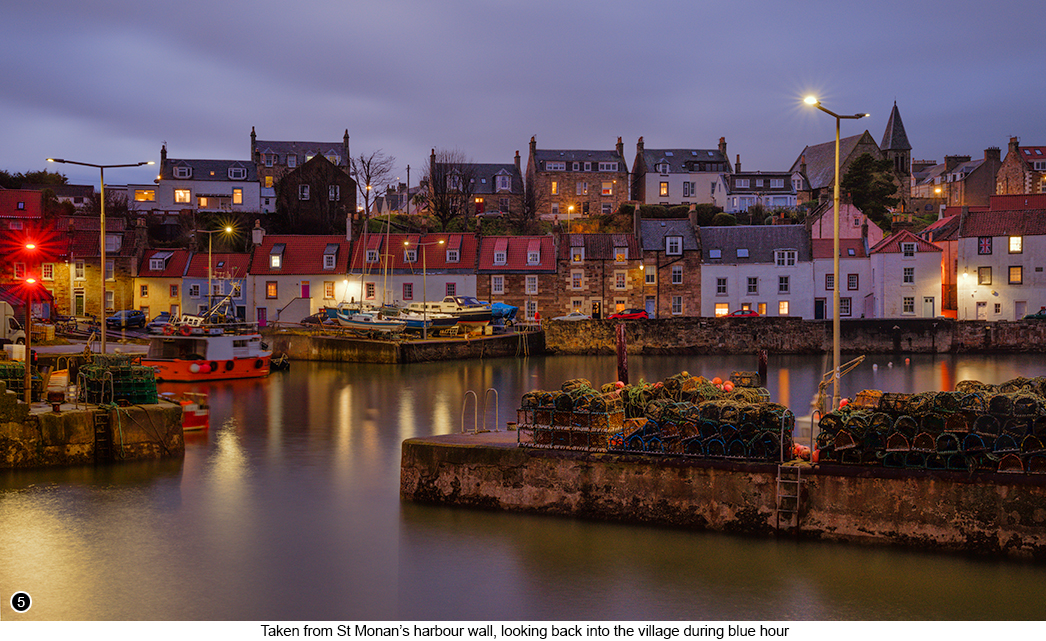 |
|
OK, rant over and I know you are not one of those types of photographers, that would even dream of taking a chance as ridiculous as that. Or that is willing to become one of those tragic human interest stories, that the press likes to tag onto the end of the early evening news. Are you? So having taken your shots the 'wonky harbour wall', if you now turn around 180 degreed during the blue hour, ie just after the sun has set. You will see this charming view of the line of old fishermen's houses, that sits tightly around the opposite side of the harbour, as shown above in SHOT5. If you then walk along the top of the harbour wall to your front, as you look towards the older wonky harbour wall on your right. You will find there is another, charming view of the village to your left, as shown in SHOT 6 below left. |
|
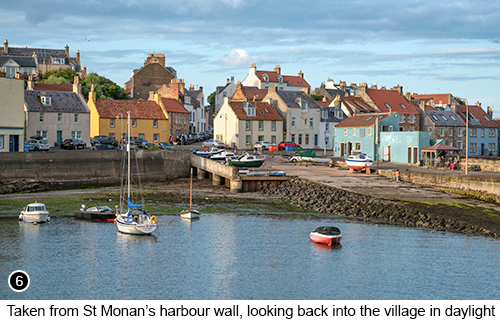 |
Then having finished shooting from the top of the harbour wall, if you now climb back down the old iron ladder and walk a little further towards the end of the main harbour wall, you will see this view of an old bell, hanging from an iron frame, as shown in SHOT 7 below. I took this shot handheld and framed it, so the bell was central within the upper third of the shot, as it just seemed to sit perfectly within this type of centralised composition. I also very much liked the brooding skies behind the bell and knew it would work well as a moody, monochrome image. This bell was once used to raise the alarm to the village and everyone who lived in it, if there was ever any fishing vessels out at sea in distress. So that the local voluntary lifeboat crew, could quickly assemble and then sail out as fast as they could, to aid the stricken vessel and her crew. So imagine if you were living in this village in the not so distant past and the men and boys of your family were out fishing, trying to earn a living and put food on the table. When suddenly you heard the ominous sounds of this bell, as it begins to toll out its bad news. Your heart would have leapt up into your throat, as you rushed out into the foul weather, to then climb up onto the harbour wall, in an attempt to see which of the boats were in distress, hoping it wasn't the one with all the men of your family on it. Hence why I gave this shot such a dramatic title. Because everyone in this tiny village over the last couple of hundred years, must have really dreaded the inevitability of that coming day, when they would finally hear the urgent clanging of this bell. |
OK, enough of the moody, heart rending stories, so let's get back to having some photographic fun shall we? So, having shot your way around the harbour wall area, if you now make your way back over to the houses side of the harbour and then continue walking around, to the opposite end of the village from where you are parked, along the West Shore Road. You will eventually come to an area with old railway lines embedded into the concrete and where some clever person, has started to grow a 'Welly Garden' over the top of the tracks. Which is about as cute as you could possibly get - not really photographic I admit, but which will hopefully put a smile on your face, as wide as it did mine, as shown in SHOT 8 below. I know this shot of the 'Welly Garden', is never going to win any awards is it? And is only here so I can try to change your mood back to happy, after reading the sad story connected to the image of the bell on the right. But this tiny welly garden is just so cute, as well as being such a lovely thing for a local to take the time to create. And I am sure everyone who walks past it, has a smile on their face as wide as a Cheshire cat. So having now spent a few minutes smiling at the welly garden and grabbing a few shots of it, continue on past it, as you now follow the West End road up a slight incline to your front right. Until you arrive at a second car park over on your left - which means you could actually go back and pick up your vehicle from the windmill car park and then drive it through to this second car park if you so desired. Which I must admit is what I did, to save my old legs from having to carry all my gear around with me etc. You will also notice, as you wander back through this village looking for shots, that all of the windows in the fisherman's cottages to your right, are really quite old style sash windows, surrounded by thick stone lintels. But where all of these stone lintels and the walls of the buildings they sit within, have been painted a wide variety of brightly clashing colours, as shown in SHOT 9 below right . These splashes of different vivid colours, really caught my eye and I immediately thought, Hhmm I know, if I set my 24-105 to autofocus and turned on IS, then I as I continued to wander around the village, I could grab several shots of these window and their lintel frames etc., and then bring them all together into a composite. I also tried to not line up any of the shots accurately within the frame, so that they would all look a bit randomly wonky (a bit like the old harbour wall then?) in the final composite image. Now I don't know if this is an original idea on my part or not, or if it is based on some other image or structure I had seen in the past. But I did know that it would work and look quite 'arty' and be very easy to do. Although I will warn you if you decide to do the same, is to be prepared to get shouted at by the locals, for taking shots of their windows and what can be seen just inside. Because there I was, working my way along the front, snapping away happily, when one of the windows suddenly slammed open and this older lady about my age, but with a strong London accent, hung out of the window and with a not so happy tone in her voice, asked what the hell I was doing? So keeping calm and trying to sound innocently upbeat, I replied that I was fascinated by all the different coloured window frames and how they had all been painted in a random but very pleasing way. I also commented that someone (the local council probably) had gone to a lot of trouble to do this and to give the village a quaint and pretty feeling to it. |
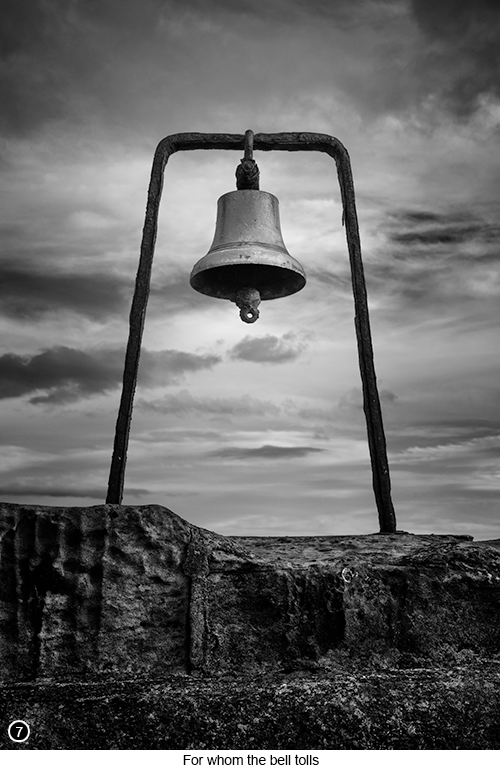 |
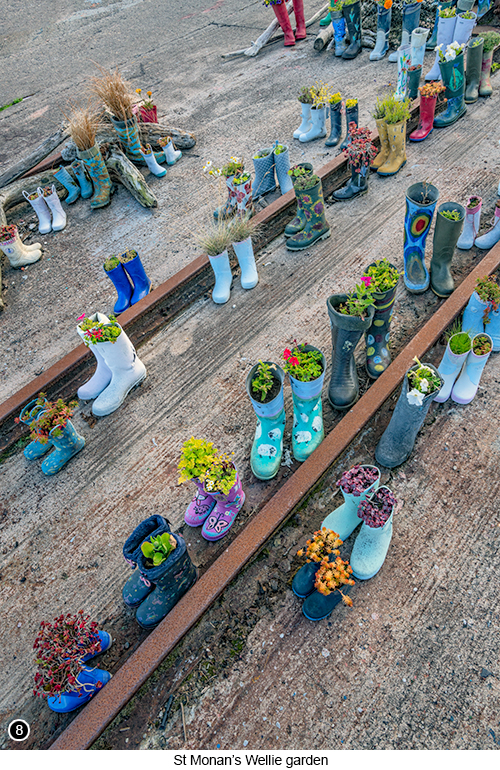 |
And as they had obviously been randomly painted like this, to look pleasing to anyone who cared to look, all I was doing, was taking photographs of the very thing I was meant to be looking at. So it was hardly my fault really, if the local people on your council, decided to make your village look so exceedingly cute and photogenic and then me, as a tourist, turned up with a camera and started taking pictures of it? This was all said with a cheery, disarming smile and a positive, happy tone in my voice by the way, as I in no way wanted to sound as if I was trying to be argumentative, or antagonistic towards her... A grunt of reluctant acknowledgement then came from her, that I was in fact making quite a good a point and that everything I was doing, was indeed in the name of 'art'. And so I wasn't just some old pervert with a camera, trying to take compromising pictures of people, through their own front windows. She then disappeared back through the opening in the window and closed it. But in a way, that was much less vigorous than the way she had opened it. So I continued doing what I was doing. Afterwards I realised, I should have given her my email address and told her to contact me, so I could then send her a copy of this file for her to look at and perhaps even have it printed if she liked it. But I suppose she made me jump and caught me off guard. So this is to the lady with the London accent with a cottage in St Monan's, who hung out of your window to shout at a photographer - if you are reading this now and you would like me to send you a copy of this file, then please get in touch via the email link at the top right of this page and I will be more than happy to send you a copy of it, as evidence of why I was taking these shots. But you will have to tell me which window you were hanging out of and if it really is you, then you will already know, that it wasn't any of the windows, I chose to include in this final version of the composite below. So continuing on with the photo tour of St Monan's: Now having reached the second car park area, just past the welly garden on your left, you will see the strange 'shark finned' rock structure on your front right of the bay, as shown in SHOT 10 below left. I have several shots of this rock structure, taken at various levels of the tide and found that I preferred the shot taken when the tide was around three quarters out. As this shows more of the upper, angular edges of the rock structure, in more detail. As well as allowing me to smooth out, the movement of the shallow water in the foreground, with a longer exposure. But if you are here when the tide is fully in, or fully out, then the shot will still work. Which means this is viewpoint, is definitely worth your attention. We are now going move up the hill along Braehead Road, to the tiny, but equally photogenic little church of St Monan's, or as it is better know, the Auld Kirk of St Monan's. Now you can do the next part of your journey through the village of St Monan's, in one of two ways. You can either walk up the hill to the church car park, or you can drive. So if you choose to do the second, then I will once again warn you how narrow the roads in this village are. However if you are young enough and fit enough, to walk up a short but a steep incline, then I suggest you walk and take in the rustic ambience of the village as you go. But if you are an old fart like me, then you will probably want to drive up the next bit. |
So having got to the top of the hill, you will see the Old Kirk of St Monan's on your left in front of you and a road that dips down to a small bridge, before it rises up once again and then into the church car park. So go into the car park and park wherever you can. You will then see the gate through the wall nearest to the church and a path that leads, into the part of the cemetery that surrounds the church - the cemetery does in fact spread out much further up the coast to your right as well. But for this shot, I chose to stay within the original cemetery area, as this seemed to be the most photographic angle I could find of the church, as shown in SHOT 11 below. The Auld Kirk of St Monan's, is thought to have been built over the top of a 9th century hermit cell, that was occupied by an old man called Monan, who became known all around this region, as having the gift of healing and who all the locals would go to, if ever they needed help. In fact he became so successful at performing his medical miracles, that families actually began to move to this region, just so they could access his services. But unfortunately for the hermit and the community that was growing up around him, the 9th century in Scotland was also the time, when marauding gangs of Vikings, on their infamous 'raping and pillaging' sprees, were common unwanted visitors. So one day the inevitable happened and the old hermit was attacked in his cell by a gang of Vikings and murdered. The news of this event, sent a shock wave through the remaining community, who gathered what little they could together, to build a makeshift shrine in his honour and where he was eventually given the status of a Saint. Then in the mid 11th century, as King David the 1st of Scotland, was sailing his small fleet across the Firth of Forth, he was caught in the middle of a violent storm. The king knew this could be his end, so quickly organised a prayer with his crew, asking St Monan to protect him and give them all safe passage. Then as soon as his ship reached the safety of the shore, he knew that his prayers had been answered, so he immediately vowed to established a church, over the top of the shrine of Saint Monan. |
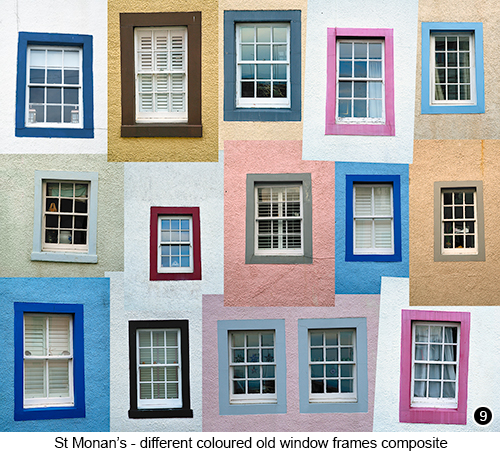 |
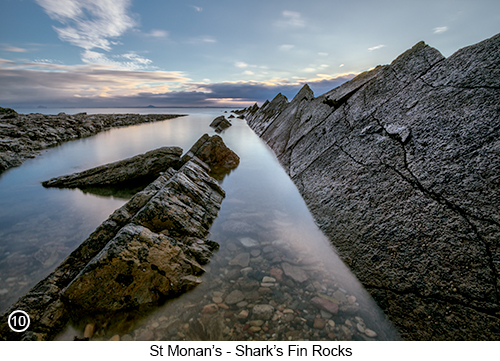 |
Tip: my advice to you, if you do intend to come here and photograph the heck out of this area of the North East coast of Scotland, as I highly recommend that you do. Is that you should plan to be here in winter (shortest amount of daylight hours), for at least two full days and where one of those days, is forecasted to be a high tide of around 4.5 to 5m, but that also coincides, with the same time the sun is due to rise or set. This way, you will be able to shoot the 'wonky' harbour wall, when the sea is crashing over the top of it and where there is also lots of colour in the sky. Because even though this location sits on the East coast of Scotland, the bay it sits in, actually points South. So in winter, the arc of the sun being so low, means it remains visible above the horizon all day long. Which then makes it is possible, to shoot the wonky old harbour wall, at both dawn and at sunset with colour in the sky, as shown in SHOTS 2 and 3 at the top of this page. Shooting here in winter, when the sun remains low in the sky for most of the day, will also give you the opportunity to take all of your shots, with lots of lovely side light, even at midday. Which will really help to model and define the shapes, of the various objects you are photographing. Such as can be seen in SHOT 1 above and SHOT 11 below. Side light if you can get it, is always a good thing for us landscape photographers and will add a sort of 3d modeling effect to the scene. Which St Monan's and the surrounding coastal area in winter, seem to have by the bucket load. I would also suggest that if you live in the UK, then other than the time and effort it will take you to drive here, there should be no other excuse, why you can't make plans to come back here and shoot this village, several other times throughout the year. |
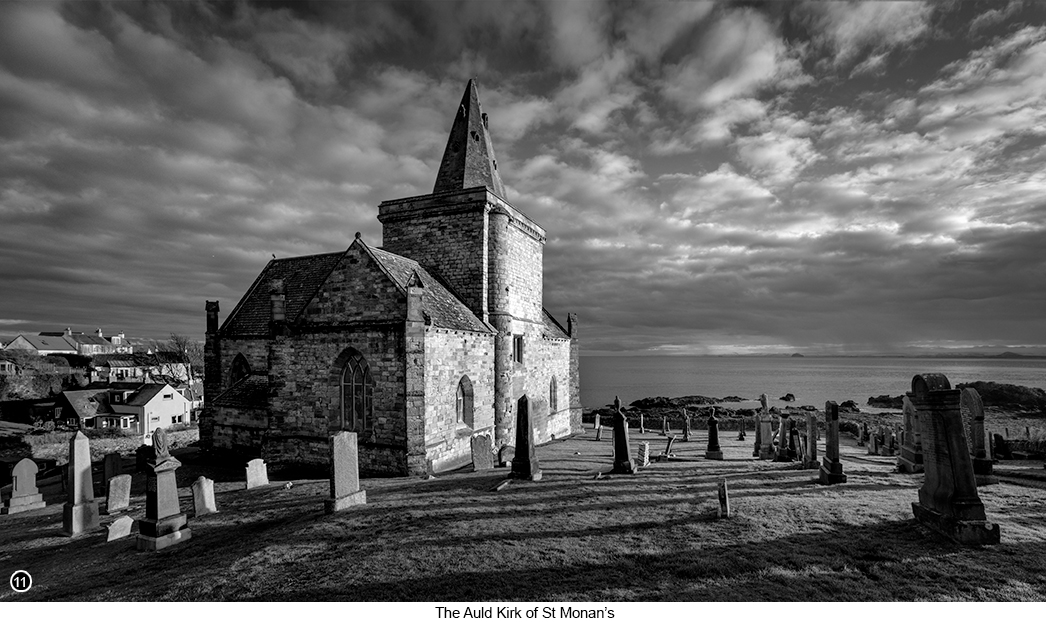 |
|
| Having now taken you on a mini virtual tour, around this tiny, but chocolate box pretty fishing village of St Monan's, I must also say, that there is a whole lot more you will find to shoot when you are here. So even though this village is very small and can be easily walked all the way around in under 15 minutes, you need to take your time when you first get here and don't just run around like a headless chicken, as you machine gun your way through the village, trying to recreate your version, of all the shots I have shown you above. Because even though the village is so tiny, it is still none the less packed throughout, with lots of other photographic opportunities, just waiting for you to find. | |
Exif information for each of the numbered shots shown throughout this chapter --1 - Canon EF16-35/2.8L USM, 1/60 Sec, f/16, ISO 100, Focal Length 26mm, taken on 2nd Dec at 11:54 --3 - Canon EF16-35/2.8L USM, 1/10 Sec, f/16, ISO 100, Focal Length 26mm, taken on 6th Jan at 08:23 --4 - Canon EF16-35/2.8L USM, 30 Sec (with 3 stop ND), f/16, ISO 50, Focal Length 31mm, taken on 6th Jan at 07:56 --5 - Sigma 24-105mm F4 DG OS HSM | Art, 30 Sec (with 3 stop ND), f/13, ISO 250, Focal Length 50mm, taken on 1st Dec at 16:44 --6 - Canon EF24-105mm f/4L IS USM, 1/100th Sec, f/16, ISO 200, Focal Length 80mm, taken on 28th July at 18:57 --7 - Canon EF24-105mm f/4L IS USM, 1/100th Sec, f/16, ISO 320, Focal Length 60mm, taken on 28th July at 19:12 --9 - Canon EF24-105mm f/4L IS USM, 1/100th Sec, f/16, ISO 320, Focal Length 105mm (15 shot composite), taken on 28th July at 19:30 (onwards) --10 - Canon EF16-35/2.8L USM, 30 Sec (with 10 stop ND), f/22, ISO 50, Focal Length 18mm, taken on 3rd Dec at 14:35 --11 - Canon EF16-35/2.8L USM, 1/100 Sec, f/14, ISO 200, Focal Length 16mm (2 shot horizontally oriented pano), taken on 2nd Dec at 13:51 |
|
If you have enjoyed reading these 'Extra' chapters to my Guide Book and think you might also enjoy reading 79 more chapters across 270 pages, that also includes more than 340 Fine Art quality images, along with detailed descriptions and large scale maps to guide you to the exact location of where I took each and every one of them and which then goes onto discuss the techniques and tools I used to process them, but where everything is written in plain easy to understand English? Then please consider buying the Book. |
|